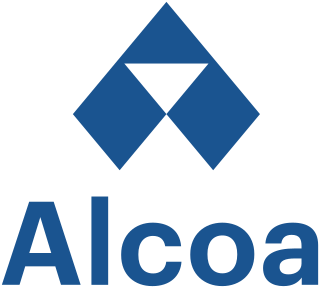
Treece is a ghost town in Cherokee County, Kansas, United States, and part of the historic Tri-State Mining District. As of the 2010 census, the city population was 138. As of May 2012 the city was abandoned and most buildings and other facilities demolished due to pervasive problems with lead pollution resulting from past mining. Two people who had refused an Environmental Protection Agency (EPA) buyout remained in 2012, then one died in 2016.

Alcoa Corporation is a Pittsburgh-based industrial corporation. It is the world's eighth-largest producer of aluminum. Alcoa conducts operations in 10 countries. Alcoa is a major producer of primary aluminum, fabricated aluminum, and alumina combined, through its active and growing participation in all major aspects of the industry: technology, mining, refining, smelting, fabricating, and recycling.

Asarco LLC is a mining, smelting, and refining company based in Tucson, Arizona, which mines and processes primarily copper. The company has been a subsidiary of Grupo México since 1999.

Commencement Bay is a bay of Puget Sound in the U.S. state of Washington. The city of Tacoma is located on the bay, with the Port of Tacoma occupying the southeastern end. A line drawn from Point Defiance in the southwest to Browns Point in the northeast serves to mark the generally accepted division between the bay and the open sound. Commencement Bay has become home to one of the most active commercial ports in the world. The Port of Tacoma is the main port facility.

Kennecott Utah Copper LLC (KUC), a division of Rio Tinto Group, is a mining, smelting, and refining company. Its corporate headquarters are located in South Jordan, Utah. Kennecott operates the Bingham Canyon Mine, one of the largest open-pit copper mines in the world in Bingham Canyon, Salt Lake County, Utah. The company was first formed in 1898 as the Boston Consolidated Mining Company. The current corporation was formed in 1989. The mine and associated smelter produce 1% of the world's copper.
The Alabama Army Ammunition Plant (ALAAP), was a United States munitions plant built and operated during World War II. The facility is located four miles (6 km) north of Childersburg, Alabama in Talladega County, Alabama.
Grupo México is a Mexican conglomerate that operates through the following divisions: Mining, Transportation, Infrastructure and Fundacion Grupo Mexico.

The Bingham Canyon Mine, more commonly known as Kennecott Copper Mine among locals, is an open-pit mining operation extracting a large porphyry copper deposit southwest of Salt Lake City, Utah, in the Oquirrh Mountains. The mine is the largest man-made excavation, and deepest open-pit mine in the world, which is considered to have produced more copper than any other mine in history – more than 19,000,000 short tons. The mine is owned by Rio Tinto Group, a British-Australian multinational corporation. The copper operations at Bingham Canyon Mine are managed through Kennecott Utah Copper Corporation which operates the mine, a concentrator plant, a smelter, and a refinery. The mine has been in production since 1906, and has resulted in the creation of a pit over 0.75 miles (1,210 m) deep, 2.5 miles (4 km) wide, and covering 1,900 acres. It was designated a National Historic Landmark in 1966 under the name Bingham Canyon Open Pit Copper Mine. The mine experienced a massive landslide in April 2013 and a smaller slide in September 2013.
The Montrose Chemical Corporation of California was a chemical corporation that was the largest producer of the insecticide DDT in the United States from 1947 until it stopped production in 1982. Its improper disposal of chemical waste from DDT production resulted in serious environmental damage to the Pacific Ocean near Los Angeles, and its former main plant in Harbor Gateway South area of Los Angeles near Torrance, California has been designated as a Superfund site by the United States Environmental Protection Agency.

Lake City Army Ammunition Plant (LCAAP) is a 3,935-acre (15.92 km2) U.S. government-owned, contractor-operated facility in northeastern Independence, Missouri, that was established by Remington Arms in 1941 to manufacture and test small caliber ammunition for the U.S. Army. The facility has remained in continuous operation except for one 5-year period following World War II. As of July 2007, the plant produced nearly 1.4 billion rounds of ammunition per year. In addition, Lake City performs small caliber ammunition stockpile reliability testing and has ammunition and weapon testing responsibilities as the NATO National and Regional Test Center. LCAAP is the single largest producer of small arms ammunition for the United States Armed Forces.
The Longhorn Army Ammunition Plant (LOW) was a 8,493-acre (34.37 km2) government-owned, contractor-operated (GOCO) facility in Karnack, Texas that was established in 1942. The Monsanto Chemical Company selected the site in December 1941 to produce TNT. The plant produced 393,000,000 pounds of TNT throughout World War II. After the signing of the Intermediate-Range Nuclear Forces Treaty on December 8, 1987, the Longhorn plant was used to destroy Pershing 1a and Pershing II missiles. The plant was operated by Thiokol.
The Lone Star Army Ammunition Plant was a 15,546-acre (62.91 km2) government-owned, contractor-operated (GOCO) facility 12 miles west of Texarkana, Texas that was established in 1942. The land was purchased from local citizens through Eminent Domain by the United States Department of Defense. The Lone Star Defense Corporation, a subsidiary of the B. F. Goodrich Rubber Corporation, won the contract on July 23, 1941 to produce artillery shells, bombs, fuses, boosters, and other auxiliary munitions at the site. The plant produced ammunition throughout World War II, the Korean War and the Vietnam War. The plant was last operated by Day & Zimmermann.

The Quincy Smelter, also known as the Quincy Smelting Works, is a former copper smelter located on the north side of the Keweenaw Waterway in Ripley, Michigan. It is a contributing property of the Quincy Mining Company Historic District, a National Historic Landmark District. The smelter was built in 1898 by the Quincy Mining Company, operating from 1898 to 1931 and again from 1948 to 1971. The smelter was part of a Superfund site from 1986 to 2013.

The Bunker Hill Mine and Smelting Complex was a large smelter located in Kellogg, Idaho, in the Coeur d'Alene Basin. When built, it was the largest smelting facility in the world. It is located in what became known as the Silver Valley of the Coeur d'Alene Basin, an area for a century that was a center of extensive silver and other metal mining and processing. This resulted in extensive contamination of water, land and air, endangering residents including the Coeur d'Alene Tribe, which had traditionally depended on fish from the waterways as part of its subsistence.

The American Brass Superfund site is a former industrial site, located in Henry County, Alabama. American Brass Inc. (ABI) operated a brass smelter and foundry facility on the site between 1978 and 1992. Prior to its closure in December 1992, the company had been cited by the United States Environmental Protection Agency (EPA), and the Alabama Department of Environmental Management, (ADEM), on several occasions for Resource Conservation and Recovery Act (RCRA) violations, arising from its waste and hazardous waste disposal processes. Site surveys, conducted by ADEM after ABI ceased operations, revealed stockpiles of 150,000 tons of contaminated waste, and extensive soil and groundwater contamination.

Silver Bow Creek is a 26-mile-long (42 km) headwater stream of the Clark Fork (river) originating within the city limits of Butte, Montana, from the confluence of Little Basin and Blacktail Creeks. A former northern tributary, Yankee Doodle Creek, no longer flows directly into Silver Bow Creek as it is now captured by the Berkeley Pit. Silver Bow Creek flows northwest and north through a high mountain valley, passing east of Anaconda, Montana, where it becomes the Clark Fork at the confluence with Warm Springs Creek.

The California Gulch site consists of approximately 18 square miles in Lake County, Colorado. The area includes the city of Leadville, parts of the Leadville Historic Mining District and a section of the Arkansas River from the confluence of California Gulch downstream to the confluence of Two-Bit Gulch. The site was listed as a Superfund site in 1983.

The International Smelting and Refining Company was a subsidiary of Anaconda Copper that operated primarily out of the International Smelter near Tooele, Utah. The International Smelter began operation in 1910 as a copper producer handling ores from Bingham Canyon and was expanded into a lead smelting operation in 1912. Copper smelting finished at International in 1946, and the lead smelter shut down in January 1972. The closure of the smelter would lead to the associated Tooele Valley Railway to be shut down ten years later in 1982. The company also handled several other Anaconda owned interests. After the shut down of several of the International Smelting sites, environmental reclamation has been performed by Anaconda Copper's successor company ARCO and the EPA Superfund program.
The U.S. Smelting and Lead Refinery Inc. site, commonly known as USS Lead, is a superfund site located in East Chicago, which is located in northwest Indiana. The site includes part of the former USS Lead facility along with nearby commercial, municipal, and residential areas. Originally the site was used as a lead ore refinery with the surrounding businesses at the time performing similar operations The primary contaminants of concern for this area are lead and arsenic. The site is currently undergoing testing and remediation. This Superfund site is broken down into two Operable Units. The first, OU1, has been divided into three zones, these being public housing complex and residential properties. OU2 includes soil at the former USS Lead facility, as well as groundwater in and around the site.
The Lava Cap Mine is an abandoned gold mine in Nevada County, California. The mine is located 5 miles (8.0 km) southeast of Nevada City. The site is undergoing cleanup by the United States Environmental Protection Agency for arsenic contamination.













